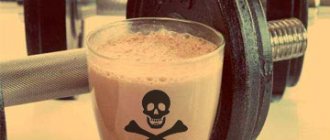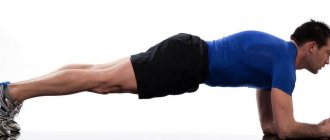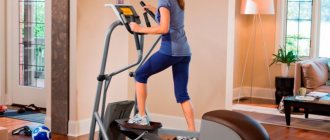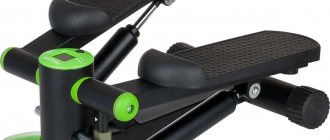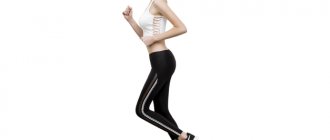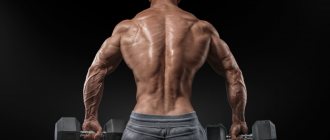You can pump up anywhere. Be it on horizontal bars and parallel bars, or in a free outdoor gym, or at home. You need a little patience, moral resistance to various distracting things, and time. Yes, muscles grow quickly only in fairy tales about “12 weeks from IT guy to Hulk” or “8 weeks from accountant to Miss Bikini.” Exercising at home can be effective if it is done deliberately. A person must understand what he is doing - basic anatomy, differences between exercises, technique, periodization should not be empty words. Do not understand? Alternatively, you can take a good program. Or evaluate in detail the technique of each movement using the video that is filmed during training. But first you need to understand a little theory and go through a couple of programs for beginners.
What happens to muscles during exercise
The most general thing is that training injures muscle fibers, nutrition and recovery help them grow. During class, we perform exercises that damage muscle fibers and create stimuli for growth. When we rest, eat enough proteins, fats and carbohydrates, and sleep, the body's hormonal levels switch to anabolism. The muscles are “repaired”, since the body “understands” that they are needed, the person will soon load them again. Over time, the muscles increase, and the person acquires the physique that he wants.
In fitness theory, changes in the body and muscle tissue are divided into training periods.
Complete beginner
Let's imagine that someone has spent their entire life on the couch. At school he had an exemption from physical education, or some irregular activities like running or football. At the university, for a couple of years he didn’t go anywhere except bars, at all, and then he saw that no one liked a belly and thin arms, and shortness of breath did not add to personal effectiveness. Our imaginary hero decided to build up his muscles.
He bought dumbbells for home, a horizontal bar for the doorway, push-up bars, and dug up a set of weights at his grandfather’s dacha. He doesn’t go to the gym, because greedy trainers there cheat newcomers out of money. He goes to YouTube, where some blogger teaches him how to do push-ups and pull-ups while compensating for part of his body weight by jumping. So our hero does push-ups, pull-ups, squats without weight, and light exercises with dumbbells.
Over the course of a month, his nervous system gets used to “digesting” the load, sleep and appetite improve, and the sore throat that plagued him at the beginning after each lesson goes away. His strength gradually increases, so he can already do more than 20 push-ups, and he is forced to purchase stops and a weighted vest.
In the first 3-4 months, the growth in strength is directly proportional to the growth in technical skill, so when working with a trainer, tasks like pumping up muscles are not set. But you can’t motivate a beginner with this! He wants to quickly see the cubes in place of a soft belly, and the peak of biceps in place of thin “chicken” arms. Therefore, a competent coach will tell the ward about proper nutrition during this difficult period. By normalizing your diet, a person will look better in a matter of weeks. This will be the first visual result.
For training at this time, exercises with body weight or minimal weights are preferable. The program is built around push-ups, pull-ups, goblet squats, lunges with minimal weight, squats without weights and straight abdominal crunches. These exercises need to be performed slowly, and you need to pay attention to your technique.
Hypertrophy
The next couple of years are turning points in the life of a novice fitness specialist. The average person doesn’t see much results from home training and quits. Yes, this is because we were taught that muscles should grow as advertised, that is, in 3-4 months we should see significant changes. After suffering for six months, a person joins the “dusty dumbbells” club. Yes, those who lose weight have a greater chance of long-term friendship with sports. They achieve results mainly through proper nutrition. The more carefully they follow their diet, the better they are able to change themselves. Such people successfully lose weight, and then begin to gain muscle mass.
In general, if you take a disciplined guy who lifts weights 3-4 times a week, increasing the load progressively, and eats for “mass growth,” he will gain about 20 kg in a couple of years. Yes, not all of it will be muscles; the fat component will also increase partly. To prevent this from “spoiling the aesthetics” too much, experts recommend alternating mass-gaining cycles with “drying.” But the fact remains unchanged - in 2 years the genetic potential for muscle hypertrophy in most natural athletes is not exhausted.
Hyperplasia
This word refers to an increase in muscle volume due to the division of muscle fibers. By the way, not all scientific studies confirm that a person, in principle, is able to increase weight due to hyperplasia. Bodybuilding experts refer to the theory of Professor Seluyanov and recommend his methods. Or they suggest training at a high volume with light weights, and they say that this way a person will gain about 10 kg of muscle.
It’s sad, but only a few manage to test words in practice. The point here is not that people are lazy to exercise, but that most theorists very heavily use not only sports nutrition, but also anabolic steroids. Here the science is clear - a person who trains on sports pharmacology is capable of muscle hyperplasia. And his weight is growing much faster.
System adaptation
They say that not every bodybuilder can get to the stage where nothing else works. It's all about the notorious life circumstances. What helps a little here is that strength sports alternate in practice. Some people start just to build up muscles, and then go to CrossFit or powerlifting to start using these muscles. Others alternate between “mass” and “drying” and delay this moment. But when adaptation occurs, it is believed that the athlete can only maintain shape and ensure that injuries do not occur.
Build muscles at home. Home workout program.
Common myths about training without iron
Muscles only grow when you lift weights.
Weights are a great way to increase the effectiveness of strength training.
However, muscles grow with any type of load. An illustrative example of effective bodyweight training are calisthenics athletes: Chris Heria, Frank Medrano and Michelle Vasquez. Fitness and bodybuilding author Brad Schonfield recommends performing 6-15 repetitions of each exercise.
Only slow loads are effective
The fast concentric phase uses a lot of fast-twitch fibers, but the eccentric phase really needs to be slow and smooth.
Home workouts are ineffective
The effectiveness of training at home depends on the correct execution of the exercise, regularity of exercise and diet. If all the conditions are met, then pumping up without dumbbells at home is a completely achievable goal.
Is it possible to pump up without exercise equipment?
Yes, you can pump up either at home or in the gym. But not everyone succeeds. Why? Lack of discipline, reluctance to learn technique, minimal knowledge about the progression of training loads. The truth is that the first couple of years a beginner should train like a powerlifter or weightlifter to gain mass naturally. Then you can apply the legacy of bodybuilding to its fullest.
What's the problem with home workouts? Of course, there is a lack of equipment. And you will miss not fashionable hack machines and some kind of cable and block exercise machines, but a power rack, a platform, a good bench press, and a competent spotter. Yes, you can strengthen your muscles without this stuff by using kettlebells and dumbbells, as well as doing pull-ups and other exercises with body weight. But if we are operating in categories like “gain 20 kg of muscle”, and not just “look like I’m rocking on the beach,” it’s better to go to the gym. Let it be the cheapest, basic, with old equipment, but for the hall.
Cardio exercises for warming up and circuit training
Jumping Jacks
This is a great warm up exercise. You simultaneously jump with your feet apart and clap overhead, and then with a jump, collect your legs and lower your arms.
Jumping rope
Jumping rope perfectly warms up the body and, with sufficient intensity, burns more calories than calm running.
Running in place with high knees
Another good exercise for cardio warm-up. The exercise is performed very intensely - approximately 70% of the maximum possible pace.
Burpee
By performing burpees in a circuit training session, you will increase your endurance and strengthen your arms. You can read about the rules and features of the exercise here.
Jump Squat
This exercise works well on the front of the thigh (three heads of the quadriceps) and calf muscles.
Rock climber
This exercise works the core muscles well and develops endurance.
Alternating Legs in a Lunge
Perform the exercise carefully so as not to hit your knee on the floor.
Newbie mistakes
To begin with, those who want to know how to pump up at home google biceps exercises and begin to do them fanatically. But the point is not at all in the biceps, but in the absence in the body of the prerequisites for creating an anabolic background. Simply put, a person simply “has nothing to grow” muscles from, especially if he neglected nutrition and believed that if he was training at home, then mashed potatoes with sausage would pass for an athlete’s diet.
The most important mistake is the reluctance to develop strength. Yes, yes, all the athletes of the “golden era” were good strength athletes. And even any modern crossfitter will perform CCM on individual movements in powerlifting. But the gloss of sports convinces us that “it will do” - bend your arms with something, do some exercises in a high-repetition mode, and you will get pumped up. No. Strength, by the way, can be developed to a certain limit at home. The only question is desire.
High expectations
Yes, guys are even worse than girls in this regard. If the latter believe that after a couple of series of glute bridges without weight and some steps to the side with elastic bands, they will look like protruding fitness bikinis, then the former are ready to argue with foam at the mouth that the same Denis Gusev could to pump up on horizontal bars if he didn’t have access to the gym. Everyone needs a role model, but if you do home fitness, you don't need to set goals like “look like a model in 3 months.”
The myth of champion volumes
Almost any person who has a photo on Instagram with huge shoulders and biceps can fit into a standard suit in life. Yes, big guys pump up their muscles before recording the results of their labors. And poor beginners do 200 repetitions with biceps expanders just to get any closer. Of course, you can develop endurance in this way, but not strength or volume.
Lack of motivation
We are not talking about videos from the Internet, where guys from the ghetto do pull-ups on the horizontal bars, and their wealthier “sports colleagues” pump iron in expensive gyms. We are talking about banal laziness. Biceps and deltoids may not be a priority for a student - for example, he is ready to play a game until 2 a.m. and then sleep through the workout. Or go have a beer instead of working out on the horizontal bars. Or... And if summer comes, you should completely forget about your studies. It's hot! In winter it is cold. In autumn - depression. And so on, in a circle. The one who will fanatically carry out the exercise program for years will get pumped up.
How to Build ALL Muscles at Home WITHOUT Iron!
Why is it hard to force yourself to go to the gym?
Everyone wants to be beautiful, slim and fit, muscular, or at least lose five extra pounds. But how often do I hear from “wants”, they say, there is no time to go to the gym, there is no sports uniform, there is no extra money, there are no normal sports complexes nearby. What don't you have there yet?
Come on, don’t stress, everything is fine, although in most cases these are all just excuses to somehow justify your inactivity. But I completely understand people and know very well how difficult it is to force yourself to go somewhere in the evening, after a difficult day at work, and start doing something instead of joyfully immersing yourself in the arms of your favorite sofa and “plugging” into the TV, game console, social networks and activities other fascinating but useless things. I went through this myself when I stopped training for eight months after the birth of my eldest son.
Why is this happening? There are no secrets here. The body simply provides exactly as much energy as a person expends day after day . Not a joule more. Our smart and, excuse me, cunning organism is configured to survive in any conditions and, in principle, it always tries to spend energy as economically as possible. That is why it can be forced to do additional work only by force of will, but gradually the body gets used to the new regime, giving out the appropriate amount of energy. Yes, you have to strain yourself, and it’s not easy.
Thus, a lazy person lying on the couch all day, a hard worker working hard at a construction site, or a programmer scribbling hundreds of lines of code will feel approximately the same in the evening, having spent completely different amounts of energy. That is, they are squeezed like lemons and there is not enough willpower to still force yourself to get out of your favorite den.
Well, ok, let's do without extreme sports and going to the gym. After all, in addition to the need to have some kind of equipment and extra money, you will find yourself in the company of strangers, it will be somehow awkward, and the inability to handle sports equipment will only increase nervous tension. By the way, it is precisely this moment of the need to integrate into a new social environment that scares many people away from going to the gym. But if you still decide to do everything in full, here is my article to help:
- I'm going to the gym. Which activity tracker to buy
If at the first stage we make do with little money, then we’ll set up a gym at home.
Exercises without machines for beginners
The truth is that it is better for a beginner not to buy equipment for home at all. It is not yet known whether he will like to study, whether he will devote enough time to physical development, or whether he will abandon the whole thing halfway and return to the sofa.
With body weight you can do:
- “air” squats and lunges;
- Bulgarian split squats with one leg resting on the sofa;
- pistol squats;
- push-ups with different hand widths;
- pull-ups with different arm widths;
- planks, supermen, crunches
The best exercises without iron
Simple squat
Stand up straight, cross your arms in front of your chest, try to keep your back vertical, and do not pull your buttocks back. With an inhalation, lower yourself down, spreading your knees to the sides, your pelvis below your knees. Exhale – stand up straight. Do not lean forward, do not change the position of your back, and do not change the position of your knees - do not bring them inward.
Lunges
This exercise is similar to a side squat. From the starting position for a simple squat, you need to step back with one leg and leave the other in the “heel under the pelvic bone” position. Then perform a squat until your knee touches the floor. You should do the same number of lunges on each leg.
Bulgarian squats
Technically, this is a lunge with the “back” leg fixed on a sofa or other support. You need to lower yourself straight, so that the knee of the front leg is not “sharp”, and the angle between the shin and the floor remains straight.
Pistol squats
Technically they resemble regular ones, but you need to stand on a low support (for example, a step or step, if you have one at home), bend your knee and lower yourself so that your pelvis is below the knee. Reaching the starting position should be done without rocking the body back and forth.
Push ups
This exercise is known to everyone from school physical education lessons. A beginner should start with the palms in the middle position - under the shoulders. Your arms should be perpendicular to the floor and your feet should be supported. The back is tense, the hips are too. You need to smoothly lower your chest to the floor, spreading your elbows, and smoothly push up from the floor.
Pull-ups
It is also better to start pull-ups with a medium grip width. Hang on the horizontal bar, palms facing away from your face, and gently bend your elbows. Pull your chest toward the bar and lower yourself straight down.
Plank and side plank
You need to take the starting position for push-ups, tighten your abs, pull in your stomach, and spend from 30 seconds to 1 minute in this static position. The side plank is an exercise on the forearm, with the side parallel to the floor.
Superman
Lying on your stomach, lift your hips and legs, as well as your arms and head, off the floor. From the outside it looks like Superman flying. An exercise can be either dynamic, when sets and repetitions are performed one after another, or static, when a person freezes at the top point and does not perform the movement dynamically.
Crunches and reverse crunches
From a lying position on the floor, you need to either lift the body and bring the lower ribs to the pelvic bones, or lift the pelvis and legs up at the same time. In both movement options, the lower back should be pressed to the floor and the abs should be tightened.
You can do other exercises - burpees, squat jumps, and lunges, but they have nothing to do with pumping up muscles. These are functional movements for developing general endurance, which are used in athletics and martial arts.
how to build muscle at home
How to organize a workout without exercise equipment
Fans of group aerobic classes are luckier: during quarantine it will not be difficult for them to carry out their usual workout at home, without equipment, simply by turning on a video lesson (for example, the same Zumba ).
The Siloviki were less fortunate. “For strength training, the ability to create a high load on the muscles is important. This is mainly achieved by increasing the working weights, but at home, as a rule, we do not have the necessary set of equipment to create the optimal load,” adds Ivan Ermolaev.
How to get out of this situation? It all depends on your level of preparation. “If your working weights are not very large, weight training with a barbell can be replaced by working with your own weight. For example, if the limit in push-ups or squats is 20 times, then this is a good replacement for strength training, says Ivan Ermolaev. — Pay attention to the small details of the technique of doing the exercises, hone them to perfection while you have time. If you do free push-ups 30-50 times, then you can increase the load. But remember that this should only be done while maintaining the correct technique. Take a video of yourself, and if you see that your technique is breaking, you shouldn’t increase the load just yet.”
Be sure to avoid basic mistakes. “The most common mistake in home workouts is a high-rep regimen (1000 and 1 repetition for the buttocks), which simply kills your mitochondria, making you less endurance,” says Sergey Kotov. — The second mistake is training too long, which will lead you to apathy and put you on the couch. The third mistake is the lack of music and closed windows. With this approach, you are more likely to end up in a hospital bed.”
Equipment for full training at home
There are ideal options, and there are low-budget ones. In the first case, a garage is allocated for training; it contains a power frame, a barbell, a platform, a bench for bench press, and a set of weights. Additionally - dumbbells. By the way, it’s not all that expensive to buy. You can search on Avito, at sales, and also from private owners. Many people will be happy to get rid of equipment they don't use. And modern equipment manufacturers make a lot of good hardware with small home gyms in mind.
If the budget is strictly limited, you will still have to choose small equipment:
- Fitness mat;
- Bench or step;
- Dumbbells with the ability to change weight - stackable;
- Horizontal bar and parallel bars, or horizontal bar and push-ups;
- Rubber shock absorbers
How to replace all this?
The steps of the ladder replace the stepper, and two strong chairs replace the push-ups. But nothing can replace the burden. Yes, you can write a lot of good things about the benefits of exercises with water bottles, sandbags, and natural stones, but this is all fine if a person knows how to hold his back. If he doesn’t know how to simultaneously gather his shoulder blades toward his spine and contract his abs, then he’s unlikely to be able to lift weights well in the same goblet squat with a water bottle.
Therefore, if you can’t buy weights for yourself, it’s better to train on parallel bars and horizontal bars for now, while looking for dumbbells and barbells at flea markets or Avito. For those who do not believe that bodyweight exercises can be difficult, there are manuals on callisthenics.
A set of exercises for all muscle groups
For beginners, it is better to practice fullbody programs at home. They don’t need splits yet, that is, differentiation into “top”, “bottom” or by muscle groups, since the fullbody will provide an overall increase in load faster.
Workout 1
- Plank – 3 minutes, broken down
- Standing Dumbbell Press – 3 sets of 12 reps
- Pull-ups with rubber or shock absorber pull to the chest from a vertical position – 3 to 10-12
- Romanian dumbbell row or forward bend with dumbbells – 3 x 10
- Classic lunges – 3 to 12.
Workout 2
- Side plank – 3 minutes on each side
- Push-ups with weights or regular 3 to 12
- Bent-over dumbbell rows 3 x 12
- Squat with 1 dumbbell on the chest – 3 to 12-15
- Bulgarian split squats without weight – 3 x 12-15
You can perform these complexes one after another every other day. The training regimen can be set every other day, or twice a week, if recovery is really bad. Ideally, increase working weights when a strength plateau occurs - take dumbbells a little heavier, but reduce the number of repetitions by two.
Progress will be difficult to achieve, but it is possible
Progress in these exercises (where the #1 goal is to gain muscle mass) can be difficult to achieve, especially as you get stronger. Because you can't adjust the weight you perform the exercise with to create a progression of loads that needs to create stress to stimulate muscle growth: you can't just add 2kg and move on to the next weight like you can with a barbell or dumbbells.
Luckily, this won't be a problem early on, as there are 2 great ways to increase your load.
The first step is to move from simple exercises to more complex ones (for example, from assisted pull-ups to simple pull-ups). Great. After this, progress in repetitions is necessary. For example, if you can only do 3 sets of 5 reps for some exercises, you can gradually increase the number of repetitions to 12 for 3 sets.
But at some point, the exercise variations will end and you will no longer be able to add reps, since there will be a high risk of starting to train for endurance rather than for muscle growth.
So what should you do then? Well, you either keep doing what you're doing and never get stronger, build muscle, or figure out a way to increase the load. For example…
- Sports vests with weights;
- Weighted belts;
- Stiffer rubber bands;
- There are rings, TRX loops and others;
- A backpack filled with books;
- Affordable and easily adjustable dumbbell sets designed to save space.
Depending on the specific exercises, there will almost always be some way to make them harder: adding some extra weight or simply making the exercises harder so that the load progresses and the muscles continue to grow.
You just need to think a little to understand the approach to each exercise you do. This is the whole key to effective training.
If you don't do this, you will end up like most people who work out at home without much thought about weights or special equipment... forever stuck at the same weight and muscle size, doing the same thing without changing anything in your training program .
Not fun at all!
Everyone who works out at home has different training conditions and equipment, and they all ask the same question... can my workouts be effective for muscle growth?
The answer obviously depends on what exactly (what equipment) the person will be working with. But if I had to just guess, I would say that in 99% of cases any exercise can be replaced by some other, similar one that could be performed in the conditions you need.
How to develop your legs
It is often mistakenly believed that jumping and jumping “swing” the legs. Repeated jumping rope, running and other cardio activities are more likely to develop endurance. To develop strength, you will either have to jump on a support, for example, a box 50 cm high, or perform movements with weights.
You can realistically do the following movements at home:
- Goblet squats and pause squats;
- Lunges with dumbbells;
- Squats with dumbbells on the chest and a rubber shock absorber;
- Dumbbell floor rows and Romanian rows
- If more significant weight is required, it is recommended to either add rubber shock absorbers, or switch to “one-legged” versions of squats and deadlifts, or, nevertheless, go to the gym.
Arm muscle development
There are just few features here - the same exercises are done as in the gym, only with dumbbells.
Bicep curls
While sitting or standing, you need to press your forearms to your body, and bend your elbows, lifting the dumbbells to your shoulders, and then slowly lower them.
Triceps overhead extensions
Sitting on a bench, lift one dumbbell behind your head and gently straighten your arms at the elbows. There is no need to “insert” your elbows until they click, smoothness is important.
Standing Dumbbell Shoulder Press
You need to stand up straight, bring the projectiles to your shoulders and smoothly move them along an arcuate path to the top of your head.
How to build muscles: basic requirements
Building muscle requires at least 2 fundamental principles.
- Progressive workouts that can stimulate growth. (A sound training plan = success.)
- A diet that can support muscle growth. (First of all, consume enough calories and protein).
As long as both principles work correctly, regularly and for a long enough time, the muscles will grow.
What should you do and use to make your muscles grow?
As you may have noticed, the main principles of muscle growth do not include a gym membership, training with free weights such as barbells and dumbbells, machines or additional equipment.
And this is because they do not play a decisive role in increasing muscle size and mass growth. These are just useful additions that can help speed up results and improve quality.
And not only in the sense that they will effectively train every muscle group and provide the muscle growth that you so desire. They simplify the progression of loads that is so necessary to stimulate muscle growth and progress in training both at home and in the gym.
That's why all gyms are filled with dumbbells from 2 to 45 kg + in 2 kg increments, barbells and plates from 2.5 kg to 20 kg (also in 2 kg increments); benches that can be adjusted to any angle; racks on which you can perform many exercises; complex, block and various exercise machines for each muscle group.
So I'm not going to lie to you here. If you want to build and pump up beautiful and strong muscles, then applying all of the above will be the best and most effective way to achieve this. Of course, you can do without something, but if you don’t have anything on this list, then this is a big problem.
But, as I already said, everything in this world is possible. There are a large number of different programs and workout options that can be used to build muscle at home without using equipment, and even the most controversial of them can work effectively when used correctly.
Features of training for girls
“Women’s” training is not much different from men’s. A newbie girl can do the same basic fullbody plan. If she wants to focus on the buttocks, you can add 1-2 sets of leg swings back with weights or a band, and hip abductions to the side. But all this is not necessary. At the beginner level, it is better to ensure regular training and avoid technical mistakes.
There are few basic rules:
- The priority is strength. Cardio can be replaced by walking, cycling, or not done at all, just walking 10,000 steps a day;
- Training should be regular, every other day. No matter how much you would like to train only “problem areas,” you need to do exercises for the whole body, otherwise the risk of injury increases;
- You still have to eat right; you can’t achieve everything through training and a “calorie deficit” alone.
Nutrition
Mass training requires at least 4 g of carbohydrates and 2 g of protein per kilogram of weight. In this case, it is better to keep fats at the level of 1 g per kilo of current body weight. Getting calories from natural foods is a must.
Recommendations:
- Drink 2-3 liters of plain water;
- Avoid empty calories from sauces, sugar and fast food;
- Eat regularly, at regular intervals
Ideal products
All these natural products will help you gain weight:
- Pasta, potatoes and sweet potatoes for carbohydrates;
- Legumes of all types - for carbohydrates and protein;
- Rice is the most accessible source of energy for a bodybuilder;
- Eggs, poultry – protein;
- Fish and seafood – protein and omega-three;
- Beef and offal – protein and iron;
- Vegetables - fiber;
- Fruits – energy of vitamins and natural simple carbohydrates;
- Nuts – for healthy fats
